In 2024, the electric vehicle (EV) market appears to be hitting a plateau compared to previous years. Recent statistics reveal a significant downturn in sales for leading EV manufacturers, especially in Australia.
According to the latest Electric Vehicle Council (EVC) report, Polestar’s sales plummeted in December, with only 178 vehicles sold compared to 406 the previous year, culminating in a total of 1,713 for the entire year. The introduction of new models like the Polestar 4—where only 120 units were delivered in December—did not produce the desired boost in performance.
Tesla, the market leader, has also faced challenges, experiencing a 17% sales decline this year, dropping from 46,116 vehicles in 2023 to 38,347 in 2024. Although the company saw a monthly increase in December, its annual numbers reflected a decline, particularly for the popular Model Y and Model 3.
Several factors contributed to this stagnation in EV sales. The removal of state subsidies, rising interest rates, and cost-of-living concerns have deterred potential buyers. To combat these issues, manufacturers have slashed prices, with MG offering the MG4 at just $30,990, significantly cheaper than many competitor hybrids.
In a recent government initiative, a new low-cost loan scheme is being introduced to assist low-income households in accessing EVs, aiming to broaden the market and counteract current barriers to entry. Looking ahead, the influx of new models in late 2024 could potentially rejuvenate EV sales and encourage more Australians to consider electric vehicles.
Is the EV Market Stalling? Understanding the 2024 Electric Vehicle Sales Landscape
Key Insights into the 2024 Electric Vehicle Market
The electric vehicle (EV) market in 2024 is showing signs of a plateau compared to its rapid growth in previous years. Recent data indicates that major EV manufacturers, particularly in Australia, are grappling with substantial sales declines. As we delve deeper into the current trends and future possibilities, we uncover insights that could shape your understanding of the ongoing evolution of the EV industry.
Current Sales Trends
According to the latest report from the Electric Vehicle Council (EVC), Polestar’s sales saw a drastic drop, reporting only 178 vehicles sold in December compared to 406 in the same month the previous year. For the entirety of 2024, Polestar managed to sell only 1,713 vehicles, even with the rollout of new models like the Polestar 4, which delivered just 120 units in December.
Tesla, the dominant player in the market, isn’t immune to these trends, facing a 17% overall sales decline this year. They went from 46,116 vehicle sales in 2023 to 38,347 in 2024, particularly marking a downward trajectory for their popular Model Y and Model 3.
Factors Behind the Slowdown
Several critical factors are causing this stagnation in EV sales:
1. Removal of State Subsidies: The discontinuation of financial incentives has made purchasing EVs more expensive for consumers.
2. Rising Interest Rates: Increased borrowing costs discourage potential buyers, particularly those considering financing their vehicle purchases.
3. Cost-of-Living Concerns: Economic pressures are forcing consumers to prioritize essential spending over luxury items, including new vehicles.
Manufacturer Responses
In response to these challenges, manufacturers have begun slashing prices to attract buyers. A notable example includes MG’s reduction of the MG4 to a competitive price of $30,990, significantly lower than many hybrid alternatives.
Innovative Solutions
The government is also stepping in with initiatives designed to make EVs more accessible. A new low-cost loan scheme has been introduced, intended to assist low-income households in purchasing electric vehicles. This initiative aims to reduce the barriers to entry and potentially broaden the market appeal for EVs.
Future Projections
Looking forward to late 2024, an influx of new EV models is anticipated, which industry experts believe could reinvigorate sales. The arrival of diverse models may attract a wider range of consumers and stimulate interest in electric vehicles.
Pros and Cons of Current EV Market Landscape
Pros:
– Competitive Pricing: Lower vehicle prices can enhance affordability and accessibility.
– Government Support: New financial programs aim to assist low-income buyers.
– Expanded Model Offerings: Upcoming releases could boost market interest and diversity.
Cons:
– Sales Decline: Major brands are experiencing downturns, which can affect consumer perception.
– Economic Concerns: External economic factors are dissuading potential buyers.
– Phase-out of Subsidies: The lack of state assistance increases financial barriers for many.
Innovations and Sustainability Trends
The current EV market is also witnessing innovations in battery technology and sustainable materials, with manufacturers increasingly focusing on eco-friendly vehicle production. Such advancements are critical as the industry faces mounting pressures to reduce its carbon footprint while meeting consumer demands.
Conclusion
In summary, while the electric vehicle market faces significant challenges in 2024, including declining sales and economic pressures, there are also opportunities for recovery and growth. The combination of competitive pricing, government initiatives, and new model introductions may help revitalize interest in EVs as we move forward.
For more information on the evolving electric vehicle landscape, visit Electric Vehicle Council.








